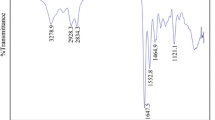Abstract
Using epoxy-terminated hyperbranched polymer (E-HBP) to modify epoxy resin (EP) is an effective way to improve the toughness of EP. In the present study, two different epoxy resin systems with E-HBP are researched: a commercial diglycidyl ether bisphenol A (DGEBA) resin with anhydride as curing agent and a tetraglycidyl diaminodiphenyl methane (TGDDM) resin with diamine as curing agent. Characterization results show that the addition of E-HBP could improve the mechanical properties of the two epoxy resin systems, such as tensile strength, elongation, and modulus of elasticity. Meanwhile, the glass transition temperature (T g ) of the two systems does not decrease. However, the morphology of the tensile fracture surfaces of the two modified systems shows different behaviors. Significant plastic deformation could be observed in the fracture surfaces of the modified DGEBA/anhydride system, and particle cavitations are clearly shown in the fracture surfaces of the modified TGDDM/diamine systems. The analysis of the tensile fracture surfaces suggests that firstly E-HBP participates in the curing process of the modified resin systems, followed by the chemical-induced phase separation; finally, a gradient transition interface layer (GTIL) is formed. Apart from these, during the external loading process, the mechanical behaviors (deformation or cavitation) of the separated E-HBP particles in the modified epoxy resins are affected by the properties of the epoxy matrix itself.

A gradient transition interface layer (GTIL) between E-HBP and the epoxy matrix can significantly enhance their interfacial interactions.












Similar content being viewed by others
References
Marouf BT, Mai YW, Bagheri R, Pearson RA (2016) Toughening of epoxy nanocomposites: nano and hybrid effects[J]. Polym Rev 56(1):70–112
Gu H, Ma C, Gu J et al (2016) An overview of multifunctional epoxy nanocomposites[J]. J Mater Chem C 4(25):5890–5906
Gu J, Liang C, Zhao X et al (2017) Highly thermally conductive epoxy nanocomposites with superior outstanding flame retardances and excellent electrical conductivities[J]. Compos Sci Technol 139:83–89
Zhang DH, Liang EB, Li TC et al (2013) The effect of molecular weight of hyperbranched epoxy resins with silicone skeleton on performance[J]. RSC Adv 3(24):9522–9529
Boogh L, Pettersson B, Månson JAE (1999) Dendritic hyperbranched polymers as tougheners for epoxy resins. Polymer 40:2249–2261
Jian YL, Yan M, Li FH et al (2013) Novel epoxidized hyperbranched poly(phenylene oxide): synthesis and application as a modifier for diglycidyl ether of bisphenol A. J Appl Polym Sci 128:907–914
Ratna D, Simon GP (2010) Epoxy and hyperbranched polymer blends: morphology and free volume. J Appl Polym Sci 117:557–564
Mezzenga R, Luciani A, Månson JAE (2002) Phase separation and gelation of epoxy resins-hyperbanched polymer blends. Polym Eng Sci 42:249–257
Li J, Xiang Y, Zheng S (2016) Hyperbranched block copolymer from AB2 macromonomer: synthesis and its reaction-induced microphase separation in epoxy thermosets. J Polym Sci A Polym Chem 54:368–380
Liu YH (2012) Polymerization-induced phase separation and resulting thermomechanical properties of thermosetting/reactive nonlinear polymer blends: a review. J Appl Polym Sci 127:3279–3292
Varley RJ, Tian W (2004) Toughening of an epoxy anhydride resin system using an epoxidized hyperbranched polymer. Polym Int 53:69–77
Zhang J, Guo QP, Fox B (2010) Thermal and mechanical properties of a dendritic hydroxyl-functional hyperbranched polymer and tetrafunctional epoxy resin blends. J Polym Sci POLY PHYS 48:417–424
Petterson B (1994) A thermosetting materials, U.S. Patent, SE 94/04440
Plastic-Epoxy compound-Determination of epoxy equivalent. National standard of China GB/T 4612–2008
Xia M, Luo YJ, Wang XY (2006) Study on curing behaviors and mechanical performances of hyperbranched polymers/epoxy curing systems[C]// Proceeding of 4th Annual Conference for Ph. D. Students of China Association for Science and Technology. 3(1):12–16
Van Velthem P, Ballout W, Horion J et al (2016) Morphology and fracture properties of toughened highly crosslinked epoxy composites: a comparative study between high and low T-g tougheners. Compos Part B Eng 101:14–20
Liu WS, Wang J, Miao RZ (2016) Molecular dynamics simulations of the cross-linked epoxy resin TGDDM/DDS[J]. Polym Mater Sci Eng 32:109–114
Mezzenga R, Boogh L, Pettersson B et al (2000) Chemically induced phase separated morphologies in epoxy resin-hyperbranched polymer blends. Macromol Symp 149:17–22
Cicala G, Recca A, Restuccia C (2005) Influence of hydroxyl functionalized hyperbranched polymers on the thermomechanical and morphological properties of epoxy resins. Polym Eng Sci 45:225–237
Hansen C (1967) M. The three dimensional solubility parameter—key to paint component affinities I.—solvents, plasticizers, polymers, and resins. J Pain Tecnol 39:104–117
Nagendiran S, Alagar M, Hamerton I (2010) Octasilsesquioxane-reinforced DGEBA and TGDDM epoxy nanocomposites: characterization of thermal, dielectric and morphological properties. Acta Material 58:3345–3356
van Krevelen DW (2010) Properties of polymers. Science Press, Beijing
Author information
Authors and Affiliations
Corresponding authors
Ethics declarations
Conflict of interest
The authors declare that they have no conflict of interest.
Rights and permissions
About this article
Cite this article
Xia, M., Yang, H., Ling, J. et al. The mechanical behaviors of epoxy-terminated hyperbranched polyester (E-HBP) as toughener in different epoxy resins. Adv Compos Hybrid Mater 1, 310–319 (2018). https://doi.org/10.1007/s42114-018-0027-4
Received:
Accepted:
Published:
Issue Date:
DOI: https://doi.org/10.1007/s42114-018-0027-4




